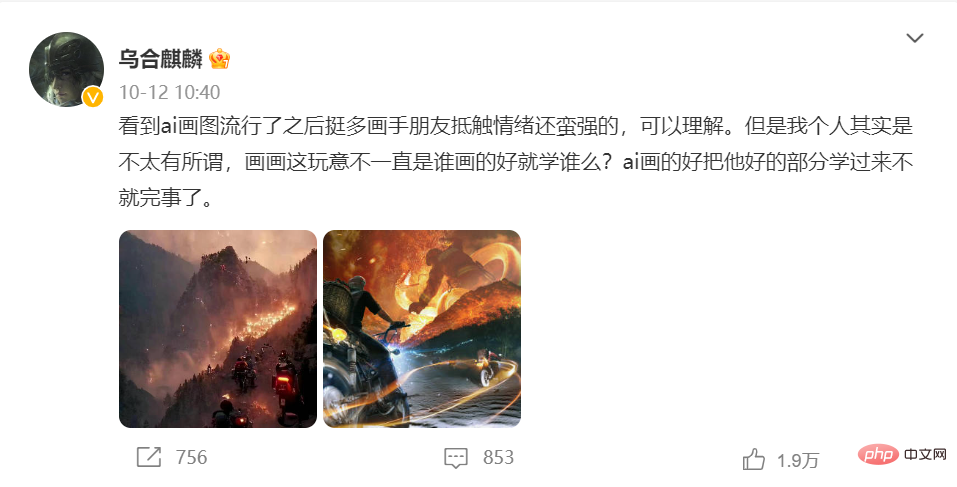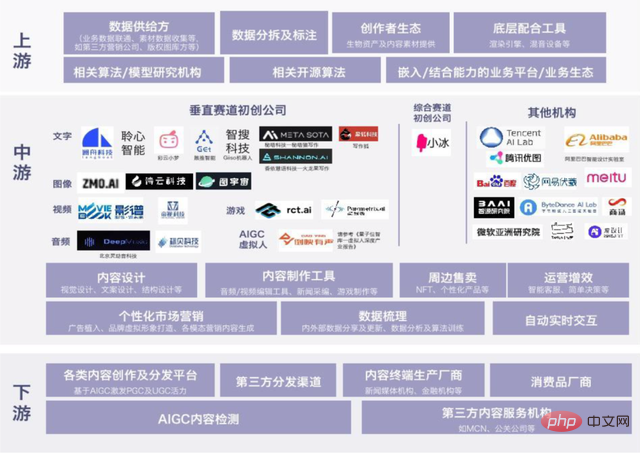
Written by Qianshan
Since this year, AIGC has risen rapidly.
The so-called AIGC, or AI-Generated Content, refers to the use of artificial intelligence to generate content, which is considered to be the successor to professionally generated content (PGC) and user-generated content (UGC). The latest new way of content creation. The “AI painting” that sparked a heated discussion not long ago is a typical example of AIGC.
In this technology track, not only many established giants continue to make plans, but there have even been several unicorns valued at over one billion US dollars.
On October 18, Stability AI announced that it had received US$101 million in financing. It is the company behind Stable Diffusion, the most popular text-to-image generator in the open source world.
On October 19, Jasper, an AI startup focusing on text generation, announced the completion of a US$125 million Series A financing, with a valuation reaching US$1.5 billion.
In addition, according to statistics, 80% of AIGC concept stocks achieved profits in the first three quarters. The venture capital circle undoubtedly favors it, and it can be said that it has been in the limelight for a while.
Why is this concept, which is not new, suddenly so popular?
From the surface, everything seems to have started with a digital event held in Colorado, USA, in August this year. Artist competition. A painting titled "Space Opera" won the digital art category. As soon as the news was announced, it caused a lot of controversy.

Opponents believe that the tireless AI "can produce a painting in 10 seconds, but it takes me several days." In the short term, its emergence will crowd out the career space of a large number of middle- and low-level painters. In the long run, it will lead to serious faults in the painting circle, and only the "big guys" will survive in the end.
What's more, it puts forward the point that "painting" is already an irreplaceable professional skill in the industry. If painters can be replaced, other professions will also be replaced. Will it be far?
Just like a netizen's comment: "I don't know where the future is. I believe that AI painting cannot completely replace humans, but it can replace me." This sense of crisis has caused many Human resonance.
Supporters believe that technological development is unstoppable, and AI painting can help painters produce content more efficiently, and sometimes even provide inspiration. Survival of the fittest is inevitable in development and will not be based on human emotions.
Of course, there are also those who hold a meaningless attitude towards this and claim that stones from other mountains can attack jade. For example, CG painter Wuhe Qilin said: "When it comes to painting, don't we always learn from whoever is good at it? If the AI is good at painting, it's all over if we just learn the good parts from him."

Source: CG artist Wuhe Qilin comments @微博
Since the birth of artificial intelligence, one thing that cannot be avoided is : Concerns about “AI replacing people” need to be faced head-on. The development of AIGC seems to have intensified this "job" struggle, but if you return to AIGC itself amid the clamor, you will find that the significance of AIGC's existence is more to release producers from boring production work, or Help producers break through production bottlenecks rather than replace practitioners. As David Holz, the founder of the AI painting tool Midjourney, once mentioned:
"I think artists are not just about the generator of images, art is often about stories and emotions, and AI has no stories and emotions. The narrative of the images created by AI comes from the people who use it. Shells all come from the sea, but the ocean is not the creator. Beautiful rocks all come from rivers, but rivers are not the creator. There is nothing created by this system Ability, but beauty can come from it."
The role of artificial intelligence in creative activities is only a tool and a carrier, not the creator itself. Holz compared artificial intelligence to water. “Water is dangerous, but you can also swim in it, build boats, and use dams to generate electricity.” The key is to learn how to use it and live with it. “It has no will, no malice. Yes, you can drown in it, but that doesn't mean we should ban water. It's really a good thing when you discover a new water source."
Although many people still have doubts about the value of AIGC, some even criticize it for wandering in morality. and the edge of the law. But to a certain extent, black and red are also red. AIGC has entered the public eye and is gradually reshaping many industry scenarios, laying a foundation for awareness and attention. The market is also generally optimistic about the development potential of this track.
According to the qubit AIGC map, AIGC is now mainly used in text, images, videos, audios, games and virtual humans. Most of the start-ups involved are concentrated in rounds A to B. , including DeepMusic, Reflection Audio, Listening Intelligence, Caiyun Xiaomeng, rct.ai, Movie Spectrum Technology, Hyper Parameters, etc.

China’s existing AIGC industry chain division
@"AIGC/AI Generated Content Industry Outlook Report"
Domestic major companies Baidu, Tencent, Alibaba, ByteDance, NetEase, etc. have also invested in the AIGC field.
However, although the prospects are optimistic by most people, there are still many problems in the field of AIGC. Fewer problems.
First, key core technologies still need to be improved. Among the criticism surrounding AI painting and AI writing, many people point out that the content it generates is stacked and has uneven quality, and sometimes even creates a funny feeling similar to "stitch monsters". A recent study by Harvard University showed that DALL-E 2 did not understand the relationship within the text prompt at all, but only glued together several entities in the text, with an image accuracy rate of only 22%.
Second, the differentiation of needs has raised the development threshold. Taking AI writing as an example, AIGC can automatically generate text based on keywords and even achieve a certain level of fluency, but different scenarios have different writing needs. For example, the wording of instructions and advertising copy are very different, and the styles of news reviews and novels are also very different. Different needs naturally lead to different training data, which undoubtedly increases the cost and time of AIGC product development.
Third, large-scale commercialization still faces many challenges. Since the current artificial intelligence is still in the traditional weak artificial intelligence stage, it must rely heavily on humans to model actual problems. However, this method is quite unstable, and coupled with the performance limitations of hardware facilities, the generated results are not ideal. , and users’ lack of willingness to pay, which means it will take some time for AIGC to be commercialized on a large scale.
Previously, Kite, an AI programming tool that once had 500,000 monthly active users, announced its failure after persisting for 8 years, which is disappointing. Its founder, Adam Smith, attributed the failure to "the algorithm wasn't good enough" and "users didn't buy it." "The biggest problem is that state-of-the-art models don't understand the structure of code, such as non-native contexts." Second, it took them a long time to discover that "individual developers don't buy tools, only their managers might. But Just making developers write code 18% faster - this is not enough to impress them."
Fourth, the dispute over the copyright of AI works has not yet been concluded. Nowadays, many AIGC tools are free and open for use, but there are still many users who are worried about the legality of their copyrights. Since the entire industry is still in the exploratory stage, different countries have different policies, and different companies have very different approaches to dealing with related issues. Therefore, the whole world is still in a period of ignorance and chaos.
The core issues in the copyright dispute mainly focus on two aspects: First, can you obtain the copyright of what the AI model creates? Second, can you use copyrighted data to train an AI model?
The lawsuit caused by GitHub Copilot not long ago is a typical case. In this class action lawsuit, programmers accused OpenAI of allegedly violating the open source license. OpenAI and Microsoft used the code they contributed to train the proprietary AI tool GitHub Copilot. Many people in the industry believe that the progress and results of this case may set a precedent for copyright ownership issues in the entire field of generative artificial intelligence.
Once upon a time, people were not enthusiastic about the application of AI in creative activities, especially in the arts. fantasy. Because AI can only rely on imitation to acquire skills, and creation is undoubtedly a unique talent of human beings. However, the emergence of AIGC seems to have broken this self-confidence of mankind, so the argument that "art is dead" has emerged again. But just as the emergence of the camera did not bring the end of painting, so did the development of AIGC.
Although we still face the challenges of immature core technology, difficulty in achieving large-scale commercialization in the short term, incomplete relevant laws and regulations, and technical ethics on the road to development, this is basically a technology It is a common problem on the development path. Collisions are inevitable and it will take time to adjust. It cannot be denied that the development of AI technology will indeed improve human productivity. On the road to constant controversy, all we need may be a little patience and a little confidence.
https://www.8btc.com/article/6776768
https://baijiahao.baidu.com/ s?id=1748281279813972418
https://view.inews.qq.com/a/20221123A0403B00
https://www.huxiu.com/article/721434.html
The above is the detailed content of How has the controversial AIGC become a top player?. For more information, please follow other related articles on the PHP Chinese website!
 Application of artificial intelligence in life
Application of artificial intelligence in life
 What is the basic concept of artificial intelligence
What is the basic concept of artificial intelligence
 Usage of urlencode function
Usage of urlencode function
 what is hadoop
what is hadoop
 The difference between sqlserver and mysql
The difference between sqlserver and mysql
 Is the higher the computer CPU frequency, the better?
Is the higher the computer CPU frequency, the better?
 How to create an index in word
How to create an index in word
 Virtual currency trading platform APP ranking
Virtual currency trading platform APP ranking
 What to do if the embedded image is not displayed completely
What to do if the embedded image is not displayed completely




